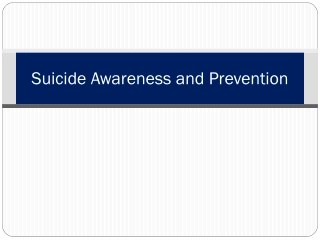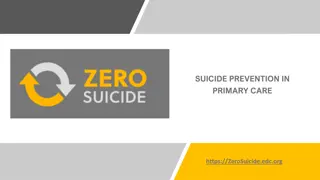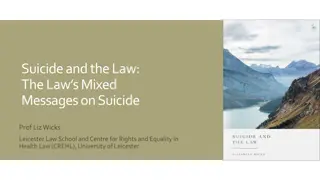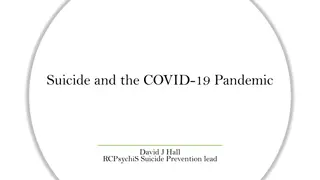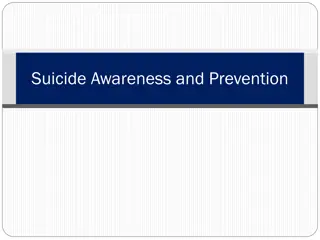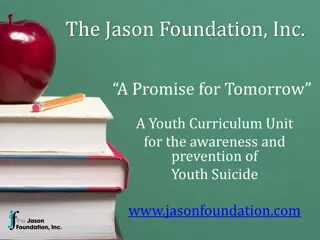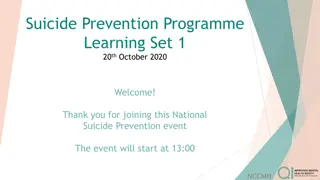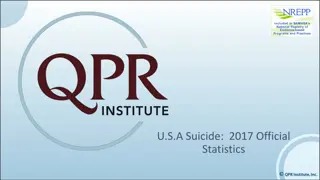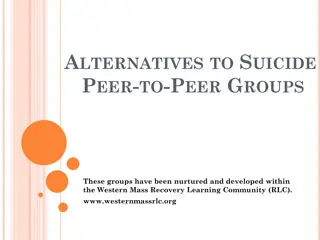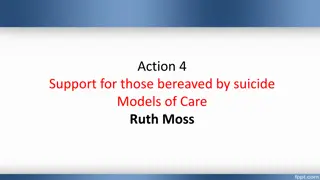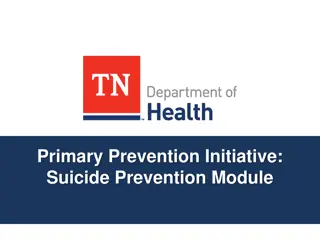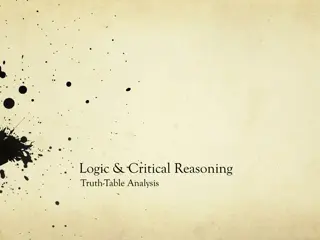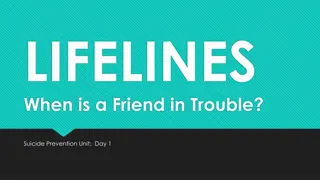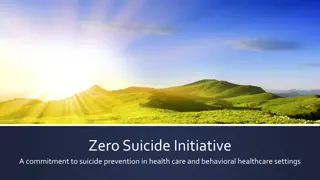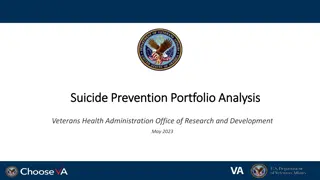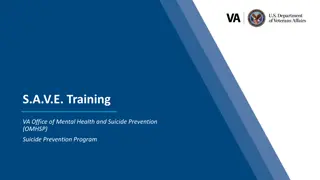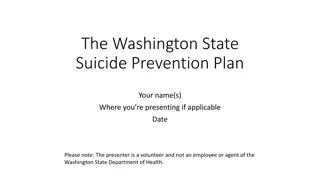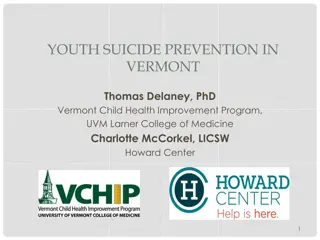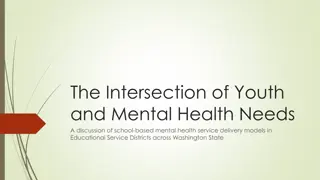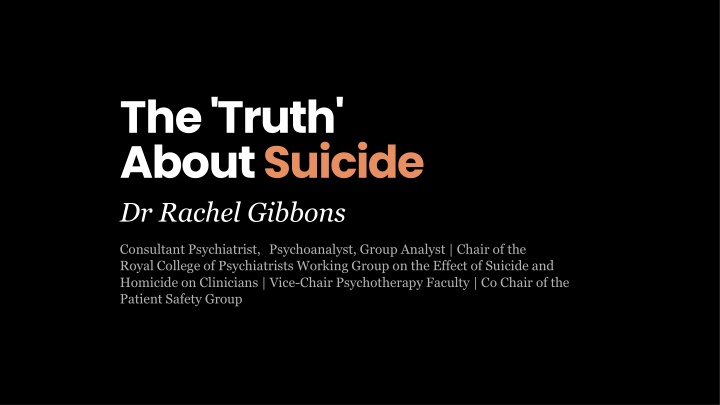
Understanding the Complexities of Suicide Pathways
Dr. Rachel Gibbons, a renowned psychiatrist, sheds light on the intricate dynamics of suicide through her insights on the factors leading to suicidal thoughts and actions. With a focus on the mental mechanisms involved, the narrative explores the universal, unconscious aspects that drive individuals to such extremes. The discussion touches upon the impulsive nature of suicide, the challenges in comprehending others' mental states, and the lingering effects on those left behind. Through a comprehensive examination, this content delves into the holistic understanding of suicidal behavior.
Uploaded on | 1 Views
Download Presentation

Please find below an Image/Link to download the presentation.
The content on the website is provided AS IS for your information and personal use only. It may not be sold, licensed, or shared on other websites without obtaining consent from the author. If you encounter any issues during the download, it is possible that the publisher has removed the file from their server.
You are allowed to download the files provided on this website for personal or commercial use, subject to the condition that they are used lawfully. All files are the property of their respective owners.
The content on the website is provided AS IS for your information and personal use only. It may not be sold, licensed, or shared on other websites without obtaining consent from the author.
E N D
Presentation Transcript
The 'Truth' About Suicide Dr Rachel Gibbons Consultant Psychiatrist, Psychoanalyst, Group Analyst | Chair of the Royal College of Psychiatrists Working Group on the Effect of Suicide and Homicide on Clinicians | Vice-Chair Psychotherapy Faculty | Co Chair of the Patient Safety Group
There is only one philosophical question and that is suicide Albert Camus
The only way out is through
To help a truly suicidal person you have to approach them with an open heart Chaplain of Beachy Head
Truths About Suicide
1. Suicide is not an accident Suicide is not an accident It is a result of complex universal unconscious mental mechanisms that we do not understand It can be highly determined
2. You will never know why someone has died by suicide
3. Impulsive vs premeditated
4. You do not know what is going on in someone else s mind
5. Everyone is shocked and surprised by the death
6. Suicide result from an incapacity to mourn
Pathway to Suicide 1. 2. 4. 5. 3. Pre-suicidal vulnerability Trigger loss event Pre-suicidal state Trigger event Suicide act Gibbons, R., 2024. Understanding the psychodynamics of the pathway to suicide: International Review of Psychiatry, pp.1-9
7. Suicide is a human condition not a mental health condition
8. Suicide prevention challenging in any individual case but not on a population or conceptual level
9. Suicide is an acting out event You act out when you cannot put your emotional experience into words
An act like this is prepared within the silence of the heart, as is a great work of art. The man himself is ignorant of it. One evening he pulls the trigger or jumps Albert Camus
Facts or Truths about suicide 1. Suicide is not an accident 2. You will never know why someone died by suicide 3. It is either impulsive or premeditated 4. You do not know what is going on in someon elses mind. 5. Everybody is shocked by the death 6. Suicide appears to result from an incapacity to mourn 7. Suicide is a human condition and not a mental health condition 8. Suicide prevention is a public health issue and talking about it reduces the risk 9. Suicide is an acting out event Suicideisnotanaccident
10. No one is to blame for someones death by suicide Blame is a non-mentalizing word It only allows for one - and the complexity and uncertainty of the situation are not considered. Responsibility is a mentalizing word
Its is our belief that we can predict and prevent individual suicide that makes us the architect of our own downfall following the suicide of a patient. We then take suicide of a patient as our own failure The truly suicidal then pose a risk to us and It makes us less likely to approach them with an open heart Gibbons, R., 2023. Eight truths about suicide. BJPsych Bulletin, pp.1-5
The Impact of Suicide on the Mindof the Bereaved (Including Staff)
21 TheMultiple Impacts ofsuicide Shocking annihilatory loss Uncertainty Fracturing of fragile construct of life Projected into by the person who has died- suicide acting out Destructive nature Leads to a fragmentation of the mind Complex bereavement- anger Delusion generated Image Jenny Saville
22 the delusion is found applied like a patch over the place where originally a rent had appeared in the ego's relation to the external world . Freud: Neurosis and Psychosis Black things Odilon Redon
Pattern of Response Initially shocked Within short space of time a delusional narrative is constructed The bereaved as the protagonist Obsessional I have made a mistake I am to blame Guilt/shame/humiliation Important transitional point- sensitive to external response Gradually more realistic development Premonition by Henryk Weyssenhoff
24 Staff Suffer Disenfranchised Grief There is not enough grief to go round I have no right to feel grief because the families grief is so much worse If I ask for any space for my feelings then it will take away, or compete with, the families grief Gibbons, R., 2024. Someone is to blame: the impact of suicide on the mind of the bereaved (including clinicians). BJPsych bulletin, pp.1-5. Hope George Friderick
25 The Effect of Suicideon Staff Profound unacknowledged trauma External responses (inc: organisational and societal) can amplify or mitigate The fear of persecution following suicide - lead to an overvalued interpretation of the role as predicting and preventing suicide. This distorts the meaning of the work The focus on working with patient to improve the quality of their life can be lost and open hearted engagement is not possible
26 Our OmnipotentRole We see our task as doing the impossible Controlling what cannot be controlled Predicting and preventing individual suicide - at all costs Even though there is no evidence that this can be achieved AT THE COST OF OUR PRIMARY TASK Atlas holding up the celestial globe Guercino
What Helps Common Emotional Reactions: Sadness, Guilt, Anxiety, Shame, Fear, Anger, Paranoia, Feelings of responsibility Fear of making mistakes or being blamed by others. Grief reactions, similar to bereavement Impact on Wellbeing: Effects can vary, Questioning clinical skills are common Looking After Yourself: Connect with others and Be kind to yourself: Maintain routine: Seek professional support: Use occupational health services, therapy, or confidential peer support.
Aimsof New Guidance 1. Recommend evidenced-based and best practice interventions to: 1. mitigate the impact of a patient death by suicide 2. improve the sustainability of mental health services increase staff wellbeing, progression with training, resilience and retention. 3. assist mental health and training organisations in their legal obligation of duty of care for their employees Increase awareness of the impact that a death of a patient by suicide can have on professionals and to: 1. encourage transparent and open dialogue about the impact on staff of working with suicide risk and death. 2. facilitate expansion of suicide prevention and awareness training to include preparation for the emotional effects and the processes that follow the death of a patient by suicide. Help support cultural transformation: 1. from one where individual clinicians may feel isolated and personally held responsible following a death, to a systemic understanding about the uncertainty and complex aetiology of suicide and its consequences on staff. Improve the quality of patient care: by helping staff feel less anxious working with suicidality and in this way maintain their capacity to think clearly and provide safe, high-quality, care. Increase the possibility of truly learning from these tragic events. To learn takes time, space for reflection and freedom from persecution. 2. 3. 4. 5.
UK Recommendations 1. Organisational pastoral suicide lead role 2. Pastoral senior management support 3. Support for the processes following the death 4. Buddy systems and other individual support 5. Group psychological support including a organisational suicide group 6. Family liaison officer (FLO), service or similar 7. Training on the effect of patient suicide on clinicians and on the processes that follow Modigliani 8. Resource availability
Gibbons, R., 2023. Eight truths about suicide. BJPsych Bulletin, pp.1-5. Gibbons, R., 2024. Someone is to blame: the impact of suicide on the mind of the bereaved (including clinicians). BJPsych bulletin, pp.1-5. Gibbons, R., 2024. Understanding the psychodynamics of the pathway to suicide: International Review of Psychiatry, pp.1-9. The Pathway to Suicide Someone is to Blame The Truth about Suicide

